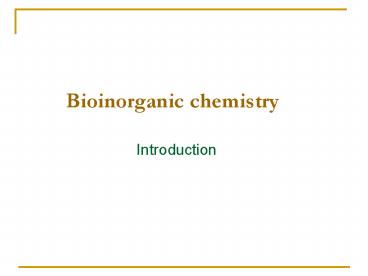Bioinorganic chemistry - PowerPoint PPT Presentation
1 / 35
Title:
Bioinorganic chemistry
Description:
Bioinorganic chemistry Introduction Bioinorganic chemistry as a highly interdisciplinary research field Evolution of life essential elements Earth solidified ~ 4 ... – PowerPoint PPT presentation
Number of Views:1980
Avg rating:3.0/5.0
Title: Bioinorganic chemistry
1
Bioinorganic chemistry
- Introduction
2
Bioinorganic chemistry as a highly
interdisciplinary research field
3
Evolution of life essential elements
- Earth solidified 4 billion years ago
- 81 stabile elements
- Elements of the living organism
- Elements in large scale 11 elements
- H, C, N, O, Na, Mg, P, S, Cl, K, Ca
- Elements in small scale 7 elements
- Mn, Fe, Co, Cu, Zn, I, Mo
- Elements of a few species 7 elements
- B, F, Si, V, Cr, Se, Sn
4
Periodic Table
5
Concentration and physiological effect
6
Metals
7
- Metals essential for life
- The role for most is uncertain
- Na, K, Mg, Ca
- V, Cr, Mn, Fe Co, Ni, Cu, Zn
- Mo, W
8
General roles of metal ions in biology
- Na, K Charge carriers
- Osmotic and electrochemical gradients
- Nerve function
Mg, Ca Enzyme activators Structure
promoters Lewis acids Mg2 chlorophyll,
photosynthesis Ca2 insoluble phosphates
9
Alkali metals
- Terrestrial distribution
- Li Na K Rb Cs Fr
- 0.060 nm 0.133 nm ionic radii
- 0.095 nm
- Distribution in vivo
- (Li) Na K (Rb)
10
- Role
- Na
- Extracellular fluid
- Osmotic balance sodium pump
- Acid-base balance
- Conformation of proteins
- nucleic acids
- Electrical impulse of nerve system
- Mg2
- 3Naic 2Kec ATP4- H2O
- 3Naec 2Kic ADP3- HPO42- H
11
- K
- Enzyme activator
- Conformation of proteins
- RNA (replication)
- Secretion of gastric acid
- Transmembrane potentials!
Complexes of alkali metals (Na, K) Cyclic
antibiotics Valinomycin Monactin Nonactin
polyethers synthetic cryptands
12
The valinomycin-potassium complex
13
The nonactin-potassium complex
14
Macrocyclic ligands
15
Alkaline Earth Metals
- Terrestrial distribution
- Be Mg Ca Sr Ba Ra
- Distribution in vivo
- Mg Ca
Be, Ba TOXIC! Sr (not particularly toxic) 90Sr
accumulates in bones
16
Alkaline Earth Metals
- Mg2
- Plants chlorosis
- CHLOROPHYLL
- nervous system (tetany)
- active transport (intracellular)
- enzyme activator (e.g. ATP-ase)
- Ca2 antagonist
- Ca2
- Inhibits Mg2-activated enzymes
- Extracellular clotting (10-3M)
- Ca2
- prothrombin thrombin-fibrinogen-
fibrin
17
Chlorofill
The mechanism of the phosphate hydrolysis
18
Transition Metals
19
Other metal ions less well defined and more
obscure roles
Fe, Cu, Mo Electron-transfer Redox proteins
and enzymes Oxygen carrying proteins Nitroge
n fixation
Zn Metalloenzymes Structure promoters Lewis
acid Not a redox catalyst!
20
- Fe(II), Fe(III)
- Essential for ALL organisms
- In plants iron deficiency
- In human body 4-5 g
- Uptake 1 mg/day
21
- In human body
- 75 Hem-iron
- Hemoglobin
- Myoglobin
- Cytochromes
- Oxidases, P-450
- 25 Non-hem-iron
- Rubredoxins
- Ferredoxins
22
- Cu(I), Cu(II)
- Plants Electron transfer
- Animals O2-carrying
Protection of DNA from O2-
- Cu-proteins and enzymes
- Cytochrome oxidase O2 H2O
- Tyrosinase, phenol oxidase ox. of phenols
- Ceruloplasmin Fe(II) Fe(III)
- Blue proteins Electron transfer
- Superoxide dismutase Elimination of O2-
- Hemocyanin O2 transport
23
Superoxide Dismutase
- SOD-Cu2 O2.- ? SOD-Cu1 O2
- SOD-Cu1 O2.- 2H ? SOD-Cu2 H2O2
24
- Role of Zn2
- deficiency
- disturbances of repr. system
- dwarfism
- skin lesions
- skeletal abnormalities
25
(Cys X Cys)7
xnonaromatic amino acid
- Zn metalloenzymes 80!
- Zn activated enzymes 20!
26
- Function of Zn in metalloenzymes
- Structure-promoter
- Substrate binder
- Lewis acid
27
Outlined structure of apoferritin
28
Iron(II)-protoporfirin IX-complex (HEM)
29
Myoglobin
Hemoglobin
30
Catalytic cycle of P-450 enzymes
31
Zink(II) in the active centre of
carboxipeptidase-A
The active centre of the alcohol dehydrogenase
32
Coordination environment of the copper centre in
azurin
33
Reversible oxygenation of hemocyanin
Structure of dimetal centre in Cu-Zn superoxide
dismutase
34
Supposed structure of Fe-S-Mo cofactor of
nitrogenase
The supposed reaction mechanism of dinitrogenase
35
Coordination environment of the Cr3 centre in
the glucose tolerance factor

